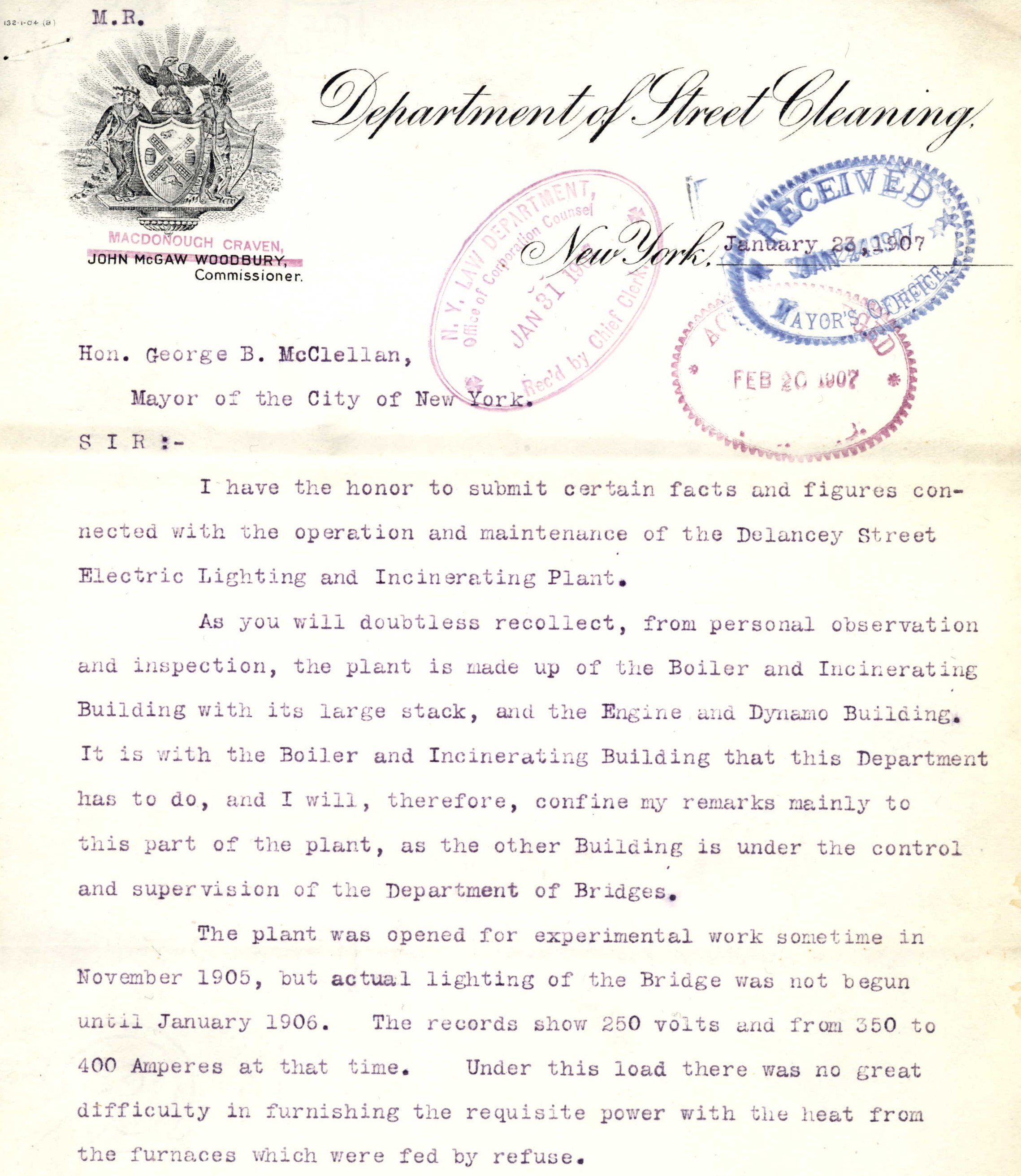“You Live in the Greatest City in the World – Let’s Make it the Cleanest and Healthiest,” is the wording on the sign on a Department of Street Cleaning cart photographed around 1908. The same sign today would not seem out of place on a Department of Sanitation truck and probably would have been a reasonable exhortation two hundred years ago. Except, until 1870, the City mostly contracted-out street cleaning services.
Rack Cart with Officer, 1908, Department of Street Cleaning Photograph Collection. NYC Municipal Archives.
The photograph of the cart is one of approximately 300 black-and-white prints depicting Department of Street Cleaning workers, equipment, and activities dating from the 1890s to 1925. Recently accessioned by the Municipal Archives, they are uniform in size, measuring approximately five by seven inches. Each is captioned on the reverse. Originally mounted in an album, the prints have been re-housed in acid-free envelopes.
Roll Call and Inspection of Drivers, 1908. Department of Street Cleaning Photograph Collection. NYC Municipal Archives.
Like many City agencies, the Department of Street Cleaning began using photography in the early years of the twentieth century to document their work. Although relatively few in number, the Street Cleaning pictures capture an essential municipal function at a time of transition from an exclusively human (and horse) powered operation to one with motorized and mechanical assistance. The many pictures of trucks, tractors, snow “scoops,” flushers, and other equipment attest to the Department’s growing reliance on machinery.
One striking feature of the photographs, especially those from the earlier time period, is the ubiquity of horses. Two recent For the Record articles, Stables and Auction Marts: Building Plans With Horses and Horsepower: The City and the Horse discussed the importance of horses to transportation, construction and recreation in the city. The Street Cleaning pictures add to that theme with an abundance of images that document how critical horses were to the Department’s mission. In addition to the many photographs of horse-pulled carts and wagons, the Street Cleaning series includes several pictures of veterinarians employed by the Department, illustrating how they cared for their equine population.
Inspection After Hook-Up, n.d. Department of Street Cleaning Photograph Collection. NYC Municipal Archives.
Department Veterinarian Treating Horse, n.d. Department of Street Cleaning Photograph Collection. NYC Municipal Archives.
Another aspect of Street Cleaning work that quickly becomes apparent in the pictures is snow, and the removal thereof. The snow-related images vividly illustrate the effort it took to clean snow from the streets. A 1915 survey of City departments, with budget information, shows that out of their total annual budget of $4.5 million, the Street Cleaning Department spent more than $650,000 to employ “contractors,” i.e. day laborers, mainly for snow removal. (Government of the City of New York, A Survey of Its Organization and Functions, 1915, Municipal Library.)
Fifth Avenue, 1908. Department of Street Cleaning Photograph Collection. NYC Municipal Archives.
Contractors Loading Snow, 1920. Department of Street Cleaning Photograph Collection. NYC Municipal Archives.
Contractor Dumping Snow into North River, 1916. Department of Street Cleaning Photograph Collection. NYC Municipal Archives.
As noted above, many of the pictures depict newly acquired mechanical equipment, obviously important to the Department as it modernized in the twentieth century. But equally apparent is the human effort needed to perform the work. “New York’s Strongest” is, and has always been, an apt motto for workers in the Street Cleaning Department.
In addition to the Street Cleaning pictures, Municipal Archives collections include a series of photographs originating from the Department of Sanitation, successor agency to the Department of Street Cleaning in 1930. The Collection Guides provide information about this larger (35 cubic feet) collection.
The Commissioner’s Carriage Before Motorization, n.d. Department of Street Cleaning Photograph Collection. NYC Municipal Archives.
Model T Ford, 1914. Department of Street Cleaning Photograph Collection. NYC Municipal Archives.
The Street Cleaning pictures have not yet been digitized, but they are available for research. In the meantime, For the Record readers can take a look at sample images from the collection. Like so many other pictures in Municipal Archives collections, the aspects that are ancillary to the subject of the photograph that add interest, e.g. the pedestrians, signs, storefronts, automobiles, and advertisements. The Street Cleaning collection is another good example.
Carts On Way to Inspection Points, n.d., Department of Street Cleaning Photograph Collection. NYC Municipal Archives.
Four-wheel Cart Used for Recruiting Help During World War, ca. 1917. Department of Street Cleaning Photograph Collection. NYC Municipal Archives.























